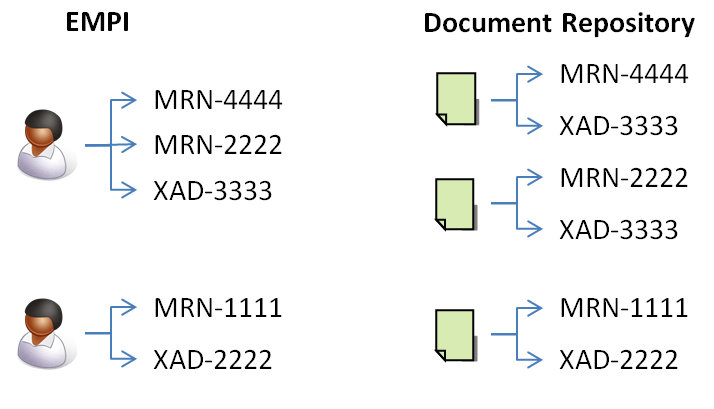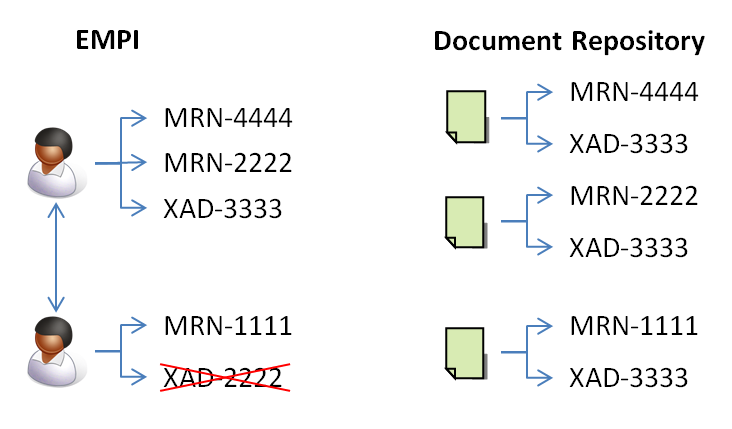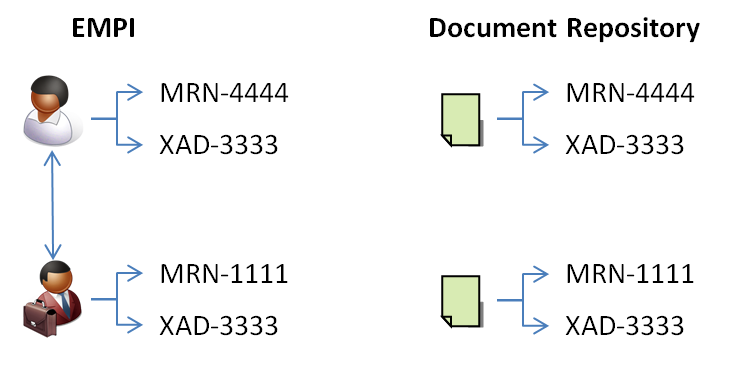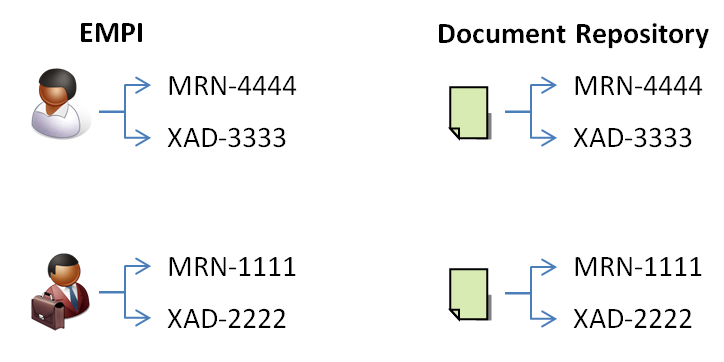Use Cases
Use Cases
This section describes the use cases that we used to define the low-level design of the notification service that is used to synchronize changes in the assignment of identifiers within OpenEMPI with external clinical data repositories that use identifiers from OpenEMPI to associated clinical documents with patients.
1. Linking or Merging Two Records
The first use case involves the linking or merging of two records into one logical cluster as a result of an update operation. This is usually the result of one of the sources of patient identity information updating one of the records to correct a mistake in one or more demographic attributes, resulting in the matching algorithm deciding to merge the two records into one logical cluster. Before the update took place, there were two distinct records in the system since the matching algorithm had made the decision that the two records referred to two distinct people. Each of the two records had an associated global identifier assigned by OpenEMPi when each of the two records were added to the system. After the update, one of the two global identifiers is retired by the system and the two records are linked together and share a common global identifier. Here is an example below to illustrate the scenario.
Initially there are two records in the EMPI for the same patient. The first record has three identifiers associated with it, two local identifiers assigned by two different clinics, and a global identifier, assigned to the record by OpenEMPI when the record was added. The record has two clinical documents associated with it in the clinical data repository. Each document is associated with the patient record to which it belongs using the global identifier but the clinical repository also keeps track of the local identifier that was assigned to the record at the clinic where the document was generated.The second patient record has two identifiers, one from the local clinic and a global identifier assigned to it by OpenEMPI. There is also one clinical document in the document repository assigned to that patient.
On a subsequent visit to one of the clinics, the registrant identifies a mistake in the demographics of the patient with local identifier MRN-1111, the demographics are corrected and an update operation is submitted to EMPI to correct the record in the EMPI. As a result of the update operation, the matching algorithm now determines that the two records are linked to each other so, the global identifier XAD-2222 is removed from the record and both records have the global identifier XAD-3333. After both the EMPi and the Document Repository have been synchronized, the patient has three identifiers associated with it in the EMPI and three documents in the clinical data repository, all three of which can be retrieved using the single global identifier for the patient of XAD-3333.
2. Unlinking or Unmerging Two Records
The second use case involves the opposite operation from the first use case where two records that were previously linked together in the EMPI are unlinked as a result of an update operation (or an explicit unlink or unmerge request by a client system of OpenEMPI). This is usually the result of one of the sources of patient identity information discovering that a patients demographics were recorded incorrectly and an update operation is generated to correct the mistake. As a result of the update, the OpenEMPI matching algorithm unlinks the two records into two logical clusters. Before the update took place, there were two distinct records in the system that had been linked by the matching algorithm. The two records shared a single global identifier assigned by OpenEMPI. After the update, the link between the two records in OpenEMPI is removed and one of the two records keeps the previously assigned global identifier whereas the other one is assigned a new global identifier.
Initially there are two records in the EMPI for the two patients. Each of the two records have two identifiers, a local one assigned by the clinic and the same global identifier which they share since OpenEMPI has decided to link the two records together. Each record also has a clinical document associated with it in the clinical data repository.
On a subsequent visit to one of the clinics, the registrant identifies a mistake in the demographics of the patient with local identifier MRN-1111, the demographics are corrected and an update operation is submitted to EMPI to correct the record in the EMPI. As a result of the update operation, the matching algorithm now determines that the two records should not be linked to each other, the global identifier XAD-3333 is now assigned only to the first of the two records, and the new global identifier XAD-2222 is created and assigned to the second record. After both the EMPi and the Document Repository have been synchronized, there are two distinct patient records in the EMPI each with its own distinct global identifier and the clinical document associated with local identifier MRN-1111 has been modified to have an identifying global identifier of XAD-2222.



